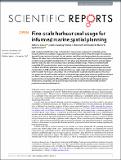Files in this item
Fine-scale harbour seal usage for informed marine spatial planning
Item metadata
| dc.contributor.author | Jones, Esther Lane | |
| dc.contributor.author | Sparling, Carol Elizabeth | |
| dc.contributor.author | McConnell, Bernie J | |
| dc.contributor.author | Morris, Christopher | |
| dc.contributor.author | Smout, Sophie Caroline | |
| dc.date.accessioned | 2017-09-19T15:30:09Z | |
| dc.date.available | 2017-09-19T15:30:09Z | |
| dc.date.issued | 2017-09-14 | |
| dc.identifier | 249183732 | |
| dc.identifier | 1b79cb3b-f20f-422f-821a-ce80c9bb3109 | |
| dc.identifier | 85029527737 | |
| dc.identifier | 000410739000079 | |
| dc.identifier.citation | Jones , E L , Sparling , C E , McConnell , B J , Morris , C & Smout , S C 2017 , ' Fine-scale harbour seal usage for informed marine spatial planning ' , Scientific Reports , vol. 7 , 11581 . https://doi.org/10.1038/s41598-017-11174-4 | en |
| dc.identifier.issn | 2045-2322 | |
| dc.identifier.other | ORCID: /0000-0002-4409-5860/work/37071294 | |
| dc.identifier.other | ORCID: /0000-0001-7575-5270/work/56052241 | |
| dc.identifier.other | ORCID: /0000-0001-7658-5111/work/89178122 | |
| dc.identifier.uri | https://hdl.handle.net/10023/11695 | |
| dc.description | The work was funded through Scottish Government MSQ0174 contract CR/2014/11; CREEM, University of St Andrews; the National Capability fund from the Natural Environment Research Council to the Sea Mammal Research Unit (grant no. SMRU1001); and MASTS pooling initiative, which is funded by the Scottish Funding Council (grant reference HR09011). | en |
| dc.description.abstract | High-resolution species distribution maps are required for marine spatial planning, consenting, and licensing to assess interactions between anthropogenic activities and ecosystems. This approach can inform conservation measures for protected species and facilitate commercial developments needed for economic growth. A case study centred on Orkney, UK, is an area where concern for a declining harbour seal population has led to constraints being placed on tidal energy generation developments. Telemetry data from 54 animals tagged between 2003 and 2015 were combined with terrestrial counts from 2008 to 2015 to produce density estimation maps. Predictive habitat models using GAM-GEEs provided robust predictions in areas where telemetry data were absent, and were combined with density estimation maps. Harbour seal usage maps with confidence intervals were produced around Orkney and the North coast of Scotland. The selected habitat model showed that distance from haul out, proportion of sand in seabed sediment, and peak flow of tidal current were important predictors of space-use. Fine-scale usage maps can be used in consenting and licensing of anthropogenic developments to determine local abundance. When quantifying anthropogenic impacts through changes to species distributions, usage maps could be spatially explicitly linked to individual-based models to inform predicted movement and behaviour. | |
| dc.format.extent | 11 | |
| dc.format.extent | 3253050 | |
| dc.language.iso | eng | |
| dc.relation.ispartof | Scientific Reports | en |
| dc.subject | GC Oceanography | en |
| dc.subject | QH301 Biology | en |
| dc.subject | DAS | en |
| dc.subject | SDG 8 - Decent Work and Economic Growth | en |
| dc.subject | SDG 14 - Life Below Water | en |
| dc.subject | SDG 15 - Life on Land | en |
| dc.subject.lcc | GC | en |
| dc.subject.lcc | QH301 | en |
| dc.title | Fine-scale harbour seal usage for informed marine spatial planning | en |
| dc.type | Journal article | en |
| dc.contributor.sponsor | NERC | en |
| dc.contributor.institution | University of St Andrews. School of Mathematics and Statistics | en |
| dc.contributor.institution | University of St Andrews. School of Biology | en |
| dc.contributor.institution | University of St Andrews. Scottish Oceans Institute | en |
| dc.contributor.institution | University of St Andrews. Marine Alliance for Science & Technology Scotland | en |
| dc.contributor.institution | University of St Andrews. Sea Mammal Research Unit | en |
| dc.contributor.institution | University of St Andrews. Centre for Research into Ecological & Environmental Modelling | en |
| dc.identifier.doi | https://doi.org/10.1038/s41598-017-11174-4 | |
| dc.description.status | Peer reviewed | en |
| dc.identifier.grantnumber | Agreement R8-H12-86 | en |
This item appears in the following Collection(s)
Items in the St Andrews Research Repository are protected by copyright, with all rights reserved, unless otherwise indicated.

